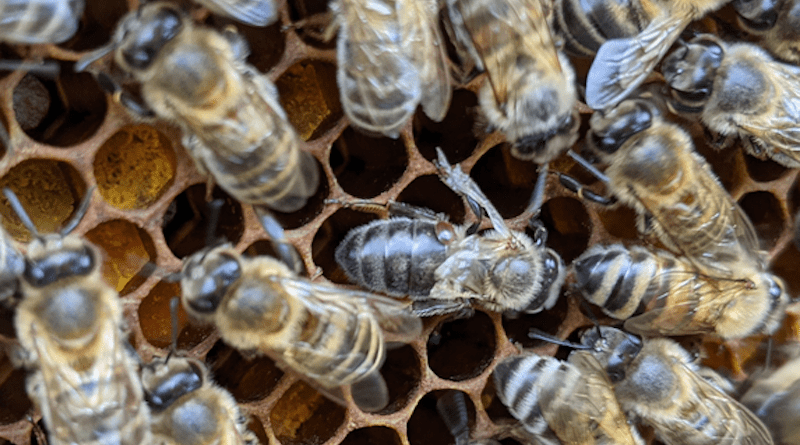Parasitic Mites’ Biting Rate May Drive Transmission Of Deformed Wing Virus In Honey Bees
Varroa destructor is an ectoparasitic mite that can cause European honey bee colonies to collapse by spreading Deformed wing virus as they feed. A study published in PLOS Pathogens by Zachary Lamas and colleagues at the USDA-ARS and the University of Maryland suggests a relatively small number of mites can contribute to a large number of infected bees.
Arthropod disease vectors transmit pathogens while feeding on susceptible hosts. However, little is known about how the feeding dynamics of Varroa spread viruses in adult honey bees. In order to better understand Varroa mite parasitism on honey bees, researchers conducted a series of experiments. First, they used fluorescent microspheres to test if Varroa were feeding on adult bees each time they entered a known feeding position. They next determined whether microspheres could be transferred from a Varroa to an adult bee via Varroa feeding by allowing Varroa to feed on bee pupae which had been injected with fluorescent microspheres. In the third experiment, researchers observed mites switching from adult bee host to host. The researchers then observed how a single mite could spread pathogens by feeding on multiple bees and calculated the relative risk of Varroa parasitism on adult workers.
Mites with high virus levels and which switched the most frequently contributed to the highest mortality in adult honey bees. Varroa are promiscuous feeders and switch hosts at a high rate. Mites switching hosts at the highest frequency were responsible for nearly three times as many parasitized hosts as their lower switching counterparts. Future studies are needed to better understand the mechanisms driving mites to switch hosts.
According to the authors, “Our work shows that viral spread is driven by Varroa actively switching from one adult bee to another as they feed. Relatively few of the most active Varroa parasitize the majority of bees. The ability to parasitize and infect multiple adult bees provides the best explanation to date for the maintenance and subsequent host-to-host spread of viruses among the long-lived worker bees common in these crowded and vulnerable colony populations”.

